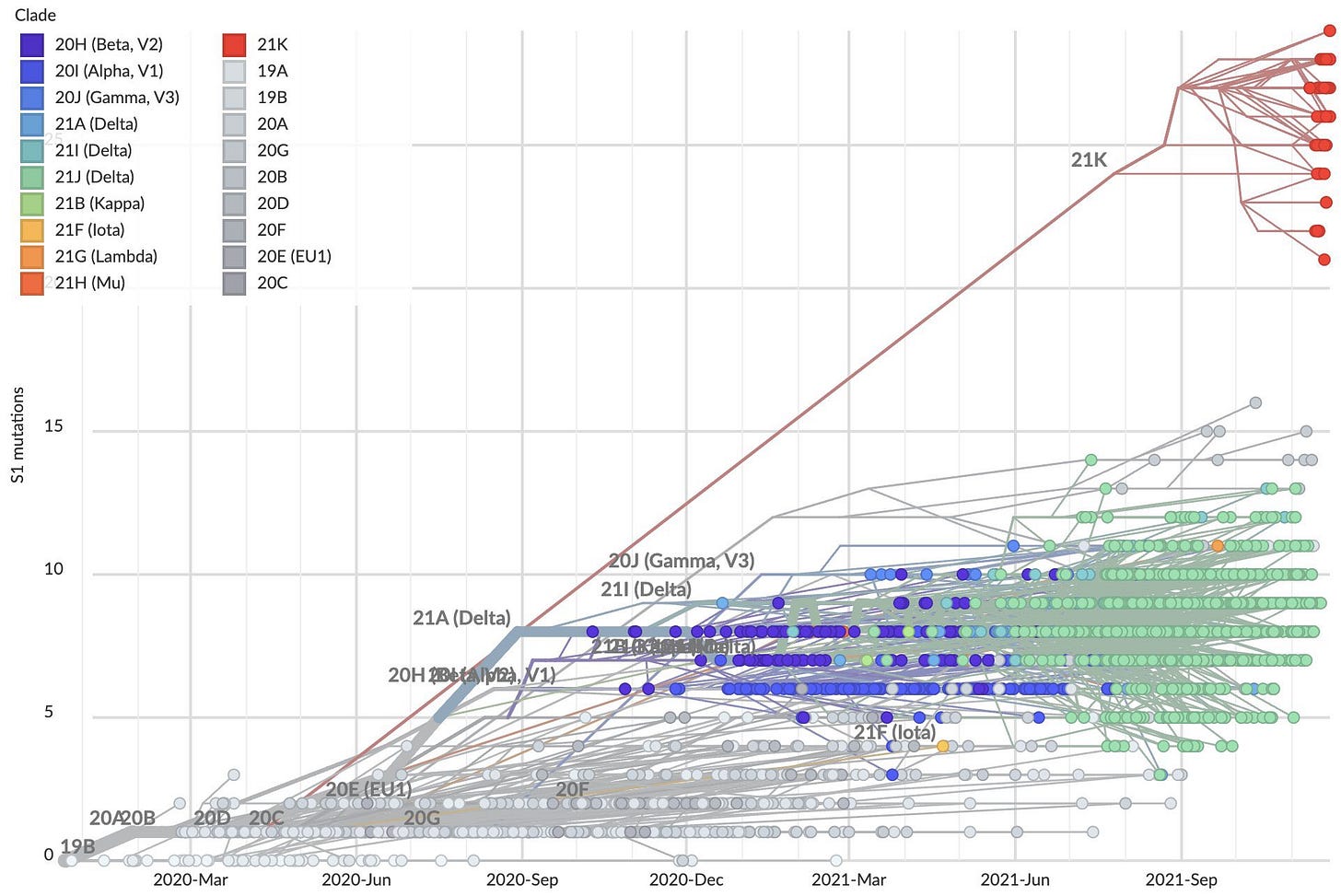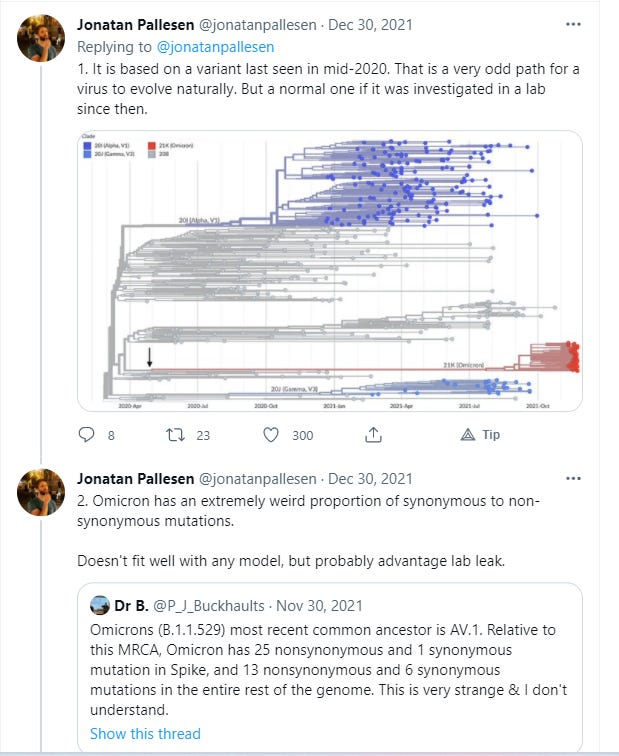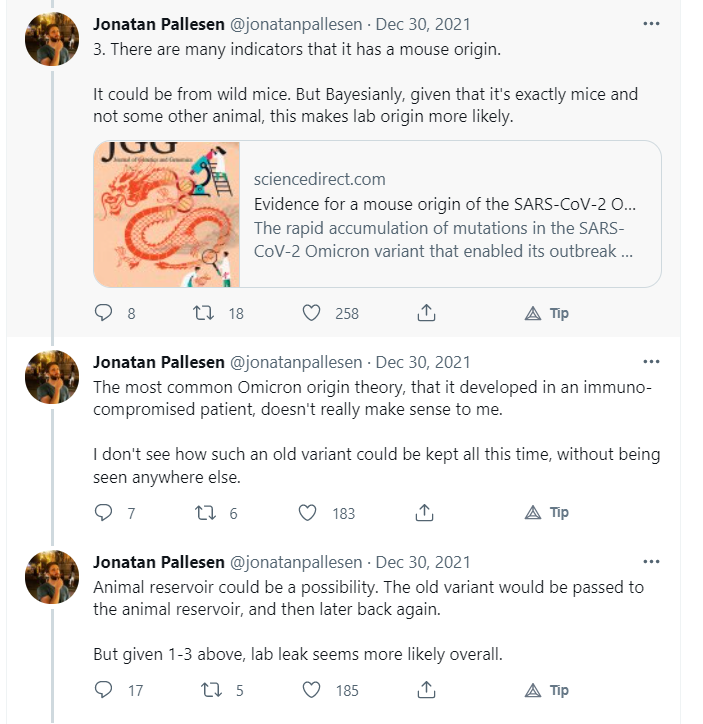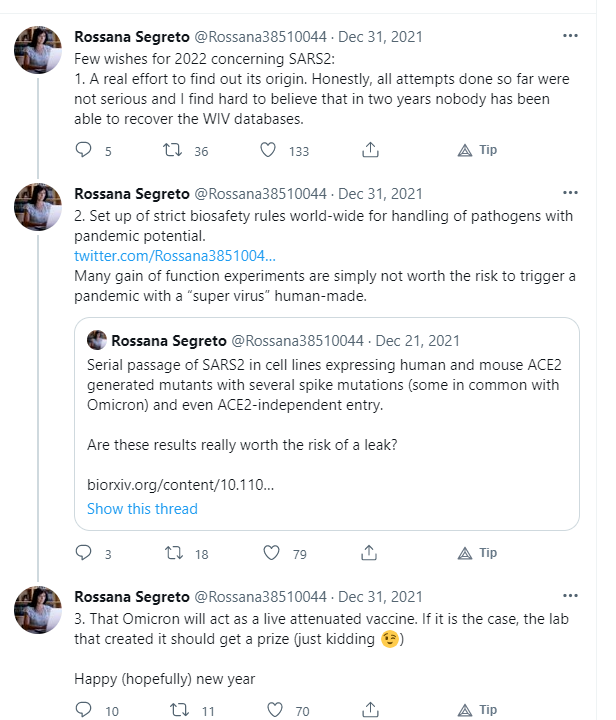Lab Leak 2.0
“If a $1000 PhD side project could kill millions of people, we must end viral [gain-of-function research], or it may end us.”
It’s like a riddle, but the answer isn’t funny:
Q: What’s worse than a virus leaking from a lab, disrupting the life of everyone on the planet, and causing the deaths of millions (equivalent to 39 Hiroshimas so far)?
A: Another lab leak two years later.
I’m talking about omicron, and no, it’s not a joke.
A Second Lab Leak? Give Me a Break! (And Trump Is Still President, I suppose?)
A lot of people haven’t yet been able to come to terms with the notion that the original COVID-19 outbreak, much less omicron, was related to a lab leak. If that’s you, I recommend reading Viral or my earlier post.
Even if this notion sounds completely far-fetched to you, please keep reading, and then decide what you think. Laboratory biosecurity incidents are, unfortunately, common. If you want to familiarize yourself with some of the major ones, a short list is here.
Martin Furmanski, an MD with a background in microbiology and a medical historian, wrote about some of these incidents in 2014 in the Bulletin of Atomic Scientists. Here’s what he wrote, for example, about the 1977 H1N1 flu pandemic:
“Human H1N1 influenza virus appeared with the 1918 global pandemic, and persisted, slowly accumulating small genetic changes, until 1957, when it appeared to go extinct… [It] reappeared in 1977, in the Soviet Union and China. Virologists, using serologic and early genetic tests soon began to suggest the cause of the reappearance was a laboratory escape of a 1949‒1950 virus, and as genomic techniques advanced, it became clear that this was true. By 2010, researchers published it as fact: ‘The most famous case of a released laboratory strain is the re-emergent H1N1 influenza-A virus which was first observed in China in May of 1977 and in Russia shortly thereafter.’ ... It continued to circulate until 2009, when the pH1N1 virus replaced it. There has been virtually no public awareness of the 1977 H1N1 pandemic and its laboratory origins…”
Why is there virtually no public awareness of a lab leak that caused suffering and disease for 32 years? Perhaps because when the World Health Organization looked into it in 1978, the scientists involved denied they were working with H1N1, and so the WHO concluded that it wasn’t a lab leak: “Nothing to see here.”
Does that sound familiar? It should. The WHO conducted a similar “investigation” in Wuhan and said a lab leak was unlikely, despite evidence to the contrary (see Part 1).
It’s no accident that Furmanski was writing about these lab incidents in 2014. At that time, gain-of-function (GoF) research was a hot topic in certain scientific circles, because of the dangers it poses to all of us.
What Is GoF and What Is It Good For?
Put in the simplest terms, GoF is research that attempts to take existing pathogens, such as viruses, and make them more dangerous to humans.
Why would anyone want to do that? Well, here’s the usual explanation: We know that certain kinds of viruses are potentially dangerous to humans if they mutate and jump from animals to people. For example, the original SARS did that in the early 2000s.
Researchers say they are trying to predict which viruses might mutate and how, by actually doing evolution’s work themselves and creating really dangerous viruses; then they study them in the lab to see what they do.
The fact that these research programs exist is not in dispute. Even people who disagree that SARS-CoV-2 was most likely caused by a lab leak acknowledge this. Many reputable scientists consider GoF programs unacceptably dangerous and have been raising the alarm for many years.
That Was Then; This Is Now
So think about the big picture for a minute. We know lab accidents are common. If we think about all the lab leaks that occurred in the 1950s, 1960s, 1970s, and so on—in the days before making viruses more dangerous to humans was “a thing”—what happened?
A virus could get out, like the H1N1 1977 flu pandemic, and it was a very bad thing, but it wasn’t worse than a natural virus. In fact, with H1N1, because so many older people had been exposed to that virus earlier in their lives and had some immunity, it made younger people sick but spared the old—only a portion of the world, and not the entire population, was vulnerable.
In other words, in earlier times, lab accidents were bad, but not quite as high stakes as they are now.
But by 2014, hundreds of scientists were concerned that with GoF becoming so common, and lab accidents happening quite frequently, a lab leak of an altered virus, specifically created to be dangerous to humans, could cause a truly disastrous pandemic. They formed the Cambridge Working Group and this is what they said about the potential dangers of this research—a full five years before any of us heard of SARS-CoV-2 or COVID-19:
“Recent incidents involving smallpox, anthrax and bird flu in some of the top US laboratories remind us of the fallibility of even the most secure laboratories, reinforcing the urgent need for a thorough reassessment of biosafety. Such incidents have been accelerating and have been occurring on average over twice a week with regulated pathogens in academic and government labs across the country. An accidental infection with any pathogen is concerning. But accident risks with newly created “potential pandemic pathogens” raise grave new concerns. Laboratory creation of highly transmissible, novel strains of dangerous viruses, especially but not limited to influenza, poses substantially increased risks. An accidental infection in such a setting could trigger outbreaks that would be difficult or impossible to control. Historically, new strains of influenza, once they establish transmission in the human population, have infected a quarter or more of the world’s population within two years.
“For any experiment, the expected net benefits should outweigh the risks. Experiments involving the creation of potential pandemic pathogens should be curtailed until there has been a quantitative, objective and credible assessment of the risks, potential benefits, and opportunities for risk mitigation, as well as comparison against safer experimental approaches. … Whenever possible, safer approaches should be pursued in preference to any approach that risks an accidental pandemic.”
So in 2014, we know dangerous pathogens were being created in labs, and there were safety incidents occurring in our highly regulated US labs every two weeks—frequently enough to alarm many reputable scientists and cause them to demand action. The scientists who signed this document excerpted above wanted to ensure the world’s safety and prevent a pandemic from being caused by a safety breach related to this type of research, which could potentially be worse than any we’d ever seen before.
In response to these concerns, the Obama White House put a temporary halt on this research to determine what the costs and benefits really were.
Business as Usual—and More Dangerous Than Ever
Unfortunately, in 2017 the furor had died down, and the National Institutes of Health allowed GoF to continue, even though nothing had been resolved.
Steven Salzberg, a Harvard-educated professor of biomedical engineering and biostatistics at Johns Hopkins University, wrote the following in a 2017 Forbes piece titled, “NIH Reopens the Door to Creation of Super-Viruses”:
“Harvard's Marc Lipsitch, one of the leaders of the Cambridge Working Group, commented that ‘we don't need to do these dangerous experiments. Indeed there are many ways that can (and have) been used to answer the public health question with greater generality, little to no safety risk, and much lower cost.’
“But just in case there is some question, let's weigh the pluses and minuses, shall we?
“Pluses:
Creating novel pathogens might lead to insights in the basic biology of viruses and bacteria.
Creating hard-to-kill pathogens might help us develop better anti-virals and anti-bacterials, although more effective strategies already exist.
“Minuses:
The viruses could accidentally escape, and millions of people could die.
The viruses could get into the wrong hands, and millions of people could die.
“…I'm leaning towards banning such research permanently.”
We know beyond a doubt: In 2014 GoF research was happening. It was temporarily put on hold, because many people found it unacceptably dangerous and the number of accidents unacceptably high. In 2017 the research was resumed, over the objections of scientists, one of whom predicted, in writing, “The viruses could accidentally escape, and millions of people could die.”
By Fall 2019, we had COVID-19, and the world has been struggling ever since.
Another Lab Leak
Presumably, as soon as SARS-CoV-2 came on the scene, lots of virologists began to study it, including people all over the world who focused their own GoF research on SARS-CoV-2. What could be more important than studying the current pandemic, right? It makes perfect sense.
But a highly transmissible virus is still going to find its way out of a lab on a regular basis. It’s dangerous to mess with it. For example, we know that the delta variant of SARS-CoV-2 leaked out of a lab in Taiwan in late 2021. You can read about it here and here.
[Edited, 5 Jan 2022, to add: Many people have been confused about the statement about delta, so I must have worded it poorly. I’m not saying delta originated in a lab leak. I’m saying delta escaped from a lab late in 2021 where it was being used in research. It’s an example of a research-related lab leak.]
To their credit, Taiwan notified the world of the leak and conducted an investigation to find out what happened. They determined there were three possible ways the worker was infected: she either inhaled the virus, was infected by contaminated gloves, or removed her mask too early. (Earlier news stories said she’d been bitten by a mouse, and how that did or did not play a role has not been clarified.)
Regardless of how it happened—it happened. Fortunately, the world was notified.
It should surprise no one that a highly transmissible virus is…highly transmissible. It can hitch a ride out of the lab on a lab worker, without anyone realizing it until it’s too late.
What About Omicron?
But what about omicron? Well—this variant appeared barely a month ago, and any information we have is subject to modification as time goes by, but here’s what we do know:
This variant is extremely weird. It does not look like a naturally evolved variant of SARS-CoV-2.
Weirdness 1: The Phylogenetic Tree
First, look at the phylogenetic tree (it’s basically a family tree for viruses). This image comes from an article in Science, which in turn got it from nextstrain.org:
The x-axis shows time, with earlier times on the left of the graph, later times on the right. The y-axis shows how mutated the viruses are, compared to the original SARS-CoV-2 and to each other. Notice how over time, with natural mutations occurring, the original SARS-CoV-2 has gradually gotten more diverse. You can see delta variants there (in green) nested in what looks like a naturally expanding variety of viruses over time. That’s the main “wedge shape” you see, and it’s what you’d expect to see.
But then look at omicron. It’s the red cluster in the upper right. It’s very, very different. It’s way off the “natural” family tree of descendants of the original SARS-CoV-2. What’s more, if you trace its “stalk” back (i.e., if you look where it branched off from the “family tree”), you see it sprang from an “ancestor” from sometime in Spring 2020.
So, how did that happen? How did it suddenly appear in November 2021, when its “forefather” was a version of the virus that was common in mid-2020?
And where is all the natural variation in between? Why is it not like the other variants, nested in that natural-looking spreading set of gradually mutating descendants?
One parsimonious hypothesis is that some engineering has been done to it, in order to make its evolution look so unnatural. I have not heard another parsimonious hypothesis.
Weirdness 2: The Proportion of the Mutations
This is hard to explain and therefore it might bore people, but …I’ll give it a shot. Skip this section if it’s too much.
All viruses as they evolve develop mutations, all the time. That’s why you see, in the image above, that gradual wedge shape, as the virus gets more and more diverse over time. There’s more similarity on the left (fewer different versions of the virus) and more diversity on the right (more versions) as time goes by. The diversity occurs because mutations occur.
There are two kinds of mutations. So-called “silent” mutations happen when the virus’s RNA has a change in a nucleotide, which does not cause an amino acid to change. What that means is: a silent mutation doesn’t change anything about how the virus works.
I’ll try to put this in terms everyone might be familiar with: Making a recipe at home.
If you were cooking up a batch of your grandmother’s homemade pasta sauce, a “silent mutation” might be: Instead of using the measuring cups handed down from your grandma, you used your roommate’s measuring cups. Something changed, but it didn’t change the sauce.
By contrast, so-called “functional” mutations do cause a change in the resulting amino acid. To use our pasta sauce analogy, something does change in the sauce itself.
As you might suppose, if mutations are random, random changes to your grandma’s sauce recipe will usually be bad for the sauce, but sometimes good.
For example, if instead of a tablespoon of salt your “mutated” recipe used a tablespoon of Drano, the sauce would be inedible. That “mutation” would die out (you’d never use that recipe again). That would be like a failed variant of a virus.
If however, instead of a quarter cup of oregano, your “mutated” recipe used a quarter cup of basil, it would still be edible sauce. Don’t tell your grandma, but maybe people would think it was even better. That would be like a successful variant of a virus.
If you consider the random nature of mutations, you can imagine that any truly random change in the recipe will be harmless if it’s “silent” (different measuring spoons, different pot, different brand of tomatoes), but it will more often than not be a bad thing if it involves a “functional” change to the recipe. If a random ingredient in your kitchen—molasses, rice, coffee, sardines, dishwashing liquid—replaces the tomato paste, how likely is the resulting recipe to be “good”?
What that means is, there are many more ways to ruin a good recipe with random changes than there are to improve it or keep it the same with meaningless changes.
So what’s up with omicron and its mutations?
Omicron has a lot of mutations, as you can see from that phylogenetic tree above. Because it has a lot of “useful” functional mutations, which seem to make it a very successful virus (equivalent to a much improved recipe), and because changes to any virus’s “recipe” are truly random if those changes occur in nature, you’d also expect to see many silent (unimportant) changes to its recipe.
In fact, based on all the other successful variants of SARS-CoV-2, scientists know the number of silent mutations they expect to see.
But they don’t find nearly enough of these silent mutations.
This Twitter thread by Tony VanDongen, an associate professor of pharmacology and cancer biology at Duke, explains this aspect of omicron. Here’s a snippet of VanDongen’s thread:
What he’s saying is, it’s highly improbable that a virus mutated this way completely randomly, because it doesn’t have enough of the silent mutations.
Scott Ferguson, a PhD in pharmaceutical sciences and a postdoc at the Harvard Center for Systems Biology, concurs (when he talks about s/ns ratios, he means the ratio of silent to functional mutations):
You can also find a lot of other reputable scientists talking about this topic if you do a search for “silent mutations omicron” on Twitter.
Weirdness 3: Its Remarkable Immune Evasion
As you may have heard, one of the most startling things about the omicron variant is its remarkable immune evasion. That means, for example, that our existing vaccines and the monoclonal antibodies we’ve been using to treat COVID patients are much less effective against it.
Phillip Buckhaults, Ph.D., is a molecular biologist and cancer geneticist at the University of South Carolina, and he says of omicron, “It has evolved to defeat three different therapeutic monoclonal antibodies. This did not happen without evolutionary pressure” (meaning, in his professional judgment this did not occur naturally).
Valentin Bruttel, who received his PhD in 2016 at the University of Würzburg (Germany) where he studied tumor immunology, autoimmune diseases, and development of biologicals, has this to add: “It's not just evolutionary pressure. It's extreme evolutionary pressure on preventing antibody binding to the spike in a very short time. (Very few silent mutations, which act like a clock, indicate it was frozen for close to 1 year.) It's either a synthetic polymutant or bred in presence of extremely well-tuned sequence of different convalescent/vaccination sera or recombinant antibodies. That many resistances can't come from one or few immunocompromised patients, which usually have B cell deficiencies, let alone animals, which initially don't have antibodies.”
Weirdness 4: The Fact that It Seems to Have Come from a Mouse (in Some Form)
So Valentin Bruttel is saying something rather commonsensical. A virus wouldn’t be expected to develop a bunch of resistances to the current human antibodies if it evolved in
An immunocompromised patient, because those patients don’t have the antibodies
An animal, because animals in natural circumstances don’t have human antibodies.
And yet those two sources, an immunocompromised patient or a mouse, are what the mainstream is telling us are the most likely “natural” way omicron arose (although even if that were the case, it wouldn’t explain weirdness 1 and weirdness 2).
The current mainstream narrative seems to be that omicron came from mice, and so Team Zoonosis is suggesting that the virus jumped from people to mice, developed immunity to antibodies that mice don’t have, developed many more mutations than would ever be found in nature in such a short time, and then jumped back to people again. Then, without explanation, it made the mouse-to-human jump, and then infected the entire world of humans with unprecedented speed, within weeks.
That is not a very parsimonious explanation. It leaves too many big questions with no reasonable answer.
However, a lot of gain-of-function experiments are done with humanized mice. Here is one example, specifically with SARS-2, ACE receptors and humanized mice, titled “Passage of SARS-CoV-2 in cells expressing human and mouse ACE2 selects for mouse-adapted and ACE2-independent viruses.”
A more parsimonious explanation for omicron, as explained by Bruttel, is
The scenario Bruttel describes might or might not turn out to be the correct scenario, but it is a parsimonious explanation that explain the aspects of omicron that demand explanation, and that tells me: Such an explanation is probably, at the very least, on the right track, compared to an “immunocompromised person” narrative or a “wild mouse” narrative.
Jonatan Pallesen, a data scientist with a PhD in genomics, sums up the lab leak hypothesis of omicron much more succinctly than I have:
Who Are These People, Anyway?
I’ve included the credentials of everyone I’ve cited, and you might notice something. These are all people whose credentials indicate that they know about genomes, mutations, microbiology, and so on, enough to know that “something ain’t right.” But they are not the people whose livelihood depends on these GoF research programs. They aren’t people like, say, Peter Daszak or Shi Zhengli, who have been promoting an arguably self-serving zoonosis hypothesis. They are also not the people directly or indirectly involved with funding this research, like Tony Fauci or other people in the US, Chinese, or other governments.
In other words, the people who are promoting the less parsimonious explanations, who are avoiding the topic of lab leaks except to call it a conspiracy theory, are those with a conflict of interest. They don’t want the world to conclude these viruses came from a lab. Those researchers don’t want the world to decide their research—their life’s work—can’t go on. Those in government don’t want to be held responsible for a global disaster.
That’s all very understandable, but 5.5 million people are dead, and we’re not done with this thing yet. It looks like this dangerous virus leaked from a lab at least three times (just as the original SARS has leaked from a lab multiple times—fortunately for us, that virus is just much less transmissible, and it never ended in a pandemic-level tragedy).
As Valentin Bruttel has said, “If a $1000 PhD side project could kill millions of people, we must end viral [gain-of-function research], or it may end us.”
What Can We Do?
Well, that’s a complicated question. I wish I had a simple answer. Rossana Segreto, a molecular biologist who was one of the first to insist that the lab leak hypothesis needed to be fully considered (see here, here and here), and who believes omicron has the hallmarks of another leak, has these wishes for 2022:
We can hope for the best, along with Segreto. But even those of us who aren’t microbiologists, biomedical engineers, molecular biologists, data scientists, geneticists, or immunologists need to play a role in moving this problem into the public eye. The stakes are too high not to.
We need to decide whom to believe: the people with a lot to lose and their not-very-parsimonious or plausible-sounding explanations, which receive almost all the media attention; or the people with expertise and parsimonious explanations who don’t have a dog in this fight. I choose to believe that people like Furmanski, the Cambridge Working Group, Lipsitch, Salzberg, VanDongen, Ferguson, Buckhaults, Bruttel, Pallesen, Segreto, and the DRASTIC research team are more likely to be on the right track.
We each need to take a direct interest in this and move it to a higher place in our list of personal priorities. COVID-19 and its variants likely won’t mean the end of humankind, but millions of people are dead, no one is being held accountable, and unless something is done to end this research, something worse will escape and potentially will mark the end of humankind. There is nothing more important we can do than to play our small part to end this.
In 2017 Steven Salzberg told us, “The viruses could accidentally escape, and millions of people could die.”
Now we’ve lived through 2019, 2020, 2021, and indeed, it looks most likely that a virus accidentally escaped (several times) and millions of people are dead, and continuing to die.
We need to make efforts to stay informed about what’s happening with these viruses and the status of GoF research. We need to tell our friends and families, to use whatever platform we might have, big or small, to promote the end of this research.
We need to get this in the public eye, so the public can demand change. We need to demand change, and not take no for an answer.
What are your ideas?










Thank you very much for an excellent essay - you explained it so well that even me, a layperson can understand it. Loved the pasta analogy. Your writing style held my interest throughout. I've subscribed and look forward to reading more....
Whether it was accident, on purpose, or natural, I hope that Omicron marks the end of this pandemic. All the narrative for vaccine passports no longer holds water. Let's start living life again!
Thank you. This really filled some gaps in my understanding of what ethical skeptic has been saying.